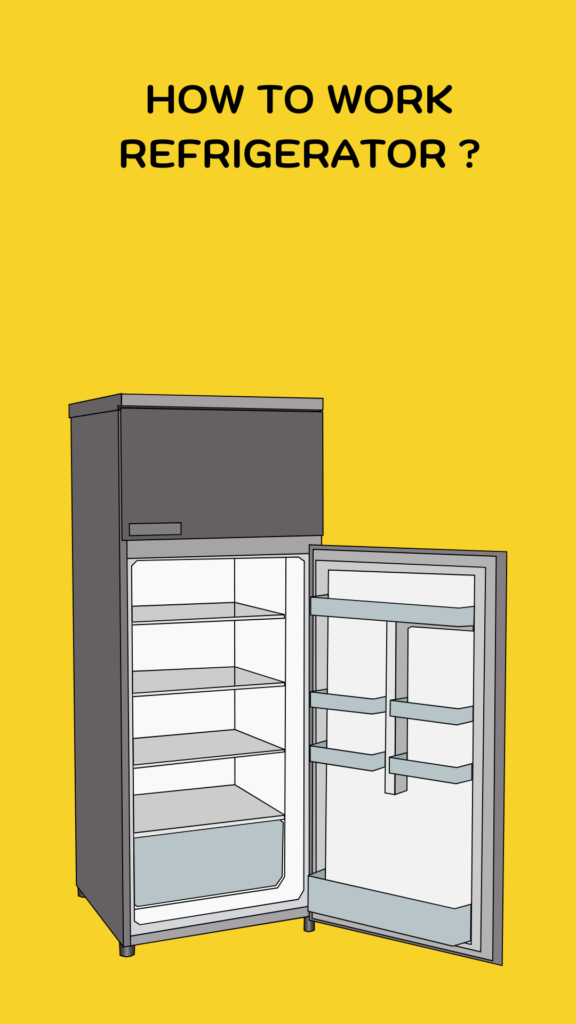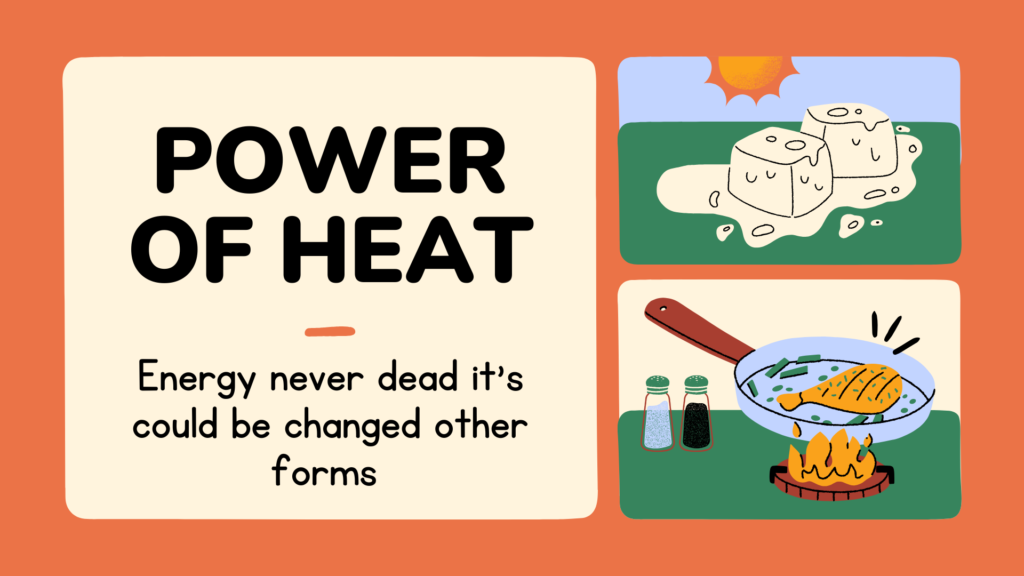How to work Refrigerator?

Theory of Physics Behind How to work Refrigerator: A unbelievable invention
Do you know how to work refrigerator?
Refrigerators are an essential part of daily life.They keep our food fresh, preserve medicine, and help maintain the overall quality of products However, how do you suppose a refrigerator operates? The physics underlying refrigerators includes ideas from heat transport, thermodynamics, and gas characteristics. Even though refrigerators are widely used, knowing how to operate one can help us appreciate this technology more. The mechanics underlying how refrigerators operate will be examined in this blog post.
Heat Transfer:
We have to know about the principle of heat transfer before we know how a refrigerator works. When temperatures are high, heat naturally moves to cooler places. For example, heat from the water’s surface transfers into the Ice once you place a piece of ice in a glass of water, melting the ice. It’s the way to refrigerator work, but it employs a refrigerant fluid that quickly changes phases to absorb and release heat rather than ice.

Refrigerator :
What do you think how to work Refrigerator?Heat is transferred from the refrigerator’s inside to the outside environment in order for it to function. Essential parts of a refrigeration system:
1. Compressor :
How to work Refrigerator?The refrigerator’s compressor is its central component. The compressor is a pump used to compress the gas known as refrigerant. Compressing the gas raises its temperature and pressure.
2. Condenser Coils:
How to work Refrigerator?can be found underneath or in the rear of the refrigerator. The gas passes through the condenser coils after being compressed. The temperature of refrigerant absorbed within the freezer is let out as it passes through these coils, cooling and condensing into a high-pressure liquid.
3. Expansion Valve:
How to work Refrigerator?This is where a small a control valve gets the high-pressure refrigerant. Through this expansion valve, the pressure decreases considerably. The temperature of the refrigerant reduces along with the pressure, forcing it to evaporate into a gas.
4. Evaporator Coils:
How to work Refrigerator?The refrigerator’s heating elements are found within, frequently next to the freezer. The evaporator coils absorb heat released by the refrigerator’s within as a cold refrigerant gas enters. This is the main cooling mechanism. The temperature inside the refrigerator is lowered by the leaking refrigerant’s ability to absorb heat.
5. Thermostat:
How to work Refrigerator?A regulator of a refrigerator regulates the temperature by monitoring the conditions within. It detects and activates the compressor if the temperature exceeds the set threshold. Once the internal temperature reaches a specific level, this device switches off the air conditioner to maintain the same temperature.
Methodical Approach How to run Cooling: (How to work Refrigeration)
How to work Refrigerator?Now that we are aware of the components, let’s go over the process in an in-depth tutorial to refrigerator functioning.
1. Compression of Refrigerant Gas:
How to work Refrigerator?The compressor compresses the low-temperature, low-pressure the refrigerant it is extracted from the coils of the evaporator. This raises the gas’s temperature and pressure. High stresses causes the refrigerant to transform into a hot gas.
2. Capacitor Heat Dissipation:
How to work Refrigerator?The heated gas flows to the condenser’s coils. Those coils, which are typically found outside the refrigerator, dissipate heat collected from within. When it regulates & goes past the coils, it cools into a liquid with a Because it transports heat from the refrigerator to the outside, this step is critical.
3. Gas Chilling and Expand:
How to work Refrigerator?The ejection gate allows high-pressure liquid refrigerant to pass through while swiftly lowering its pressure. As a result of the pressure fall, the temp of the liquid decreases dramatically, transforming it into a cold gas. Because of the fast temperature drop, the refrigerator’s nitrogen could hold heat.
4. Wiper Heat Absorbance:
How to work Refrigerator?Cooling gas is taken up by the refrigerator’s cooling coils to chill the air. It cools the air and items within the refrigerator by absorbs heat from them, which then evaporates and re-forms as a gas
5. Continuous Cycle:
How to work Refrigerator?As the air compressor receives the refrigerant gas, that is now low in force and humidity, the cycle continues. Compression, growing, heat absorption, and release are the continuous cycles that keep the refrigerator cold.
Why Do Refrigerator Phase Changes Occur?
How to work Refrigerator?Phase-changing ability of the refrigerant is critical to the process outlined above. Heat is absorbed by the cooling system coils as the cold air evaporates. Evaporative cooling is an efficient way to chill the air within the refrigerator.The heat which was absorbed inside disappear as the refrigerant reduces in the coils that convert it into a gas to a liquid. Because it takes comparatively less energy to transform from a gas to a liquid or vice versa, the refrigerant experiences phase shifts. If the refrigerant were just warming up or freezing down without changing phases, the system would not be able to take in and remove heat as effectively.
Principles of Thermodynamics:
The laws of thermodynamics may be used to understand how a refrigerator operates. The following are the main thermodynamic concepts that control refrigeration:
The conservation of energy, and theory of thermodynamics:
remains that energy can only be moved or transformed from one kind to other; it cannot be created or destroyed. Moving the refrigerant throughout the system needs mechanical energy, which the compressor in the refrigerator transforms into electrical energy. A refrigerator transfers heat from its interior to its exterior.
Thermodynamics' second law (entropy):
According in this law, heat normally moves from hot to cold locations. In order to transfer heat from the cold interior to the warmer exterior, refrigerators use another source, which is why they are the compressor. Because it defies the heat’s natural flow, this process uses energy.And this is why refrigerators consume electrical energy.
Theory of Heat Pump:
The heat pump theory states that refrigerators is a system of heating that transfers heat from one place to another. The refrigerator’s outside retains its coolness by transferring heat from inside.
Conclusion:
How to work Refrigerator?The refrigerator’s operation depends on a complicated yet distinct relationship between heat transmission, thermodynamics, and refrigerant properties, despite the fact that it may seem like a simple household appliance. In order to maintain a cool atmosphere, refrigerators effectively move heat from the interior of the device to the exterior by shrinking, relaxing, expanding, and emptying a refrigerant.Studying the basic principles of the laws of thermodynamic mostly the second law, which explain the heat’s inherent propensity to move from hot to cold, is essential to comprehending how this commonplace technology works. Thus, the next time you reach for a cold beverage from the refrigerator, pause to consider the complex physics that enables it. An excellent illustration of how scientific ideas might be applied to enhance our everyday lives is the refrigerator.
History of computer
Frequently Asked Questions (FAQ)
Q1 In terms of functions, what is a refrigerator essentially?
A refrigerator removes heat from the inside and dumps it outside to keep all the food and other things cold and fresh. A refrigerant, and a cycle of compression, condensation, expansion, evaporation are used by it to cool down.
Q2: How does an fridge cool down air in it?
It relies on evaporator coils and a refrigerant that uses evaporation to absorb heat from within as it remains a gas. The process used to cool the air, and when it absorbs the heat from the inside the refrigerant would release this heat and carry it away to outside through condenser coils.
Q3: Why the phase of refrigerant (liquid to gaseous and revert)?
Refrigerant changes state for the efficient heat absorption and heat discharge. It absorbs not-low but extremely low temperature when it evaporates and releases, that heat to the environment when condenses.
Question 4: How the Compressor works?
Compressor Raise the pressure of the refrigerant gas, reducing it’s temperature and force through the process. The “heart” of the refrigeration cycle, it keeps it all going.
Question 5: Is refrigerator keep cooling all the time?
No. Thermostat monitors temperature and cycles on/off the compressor to achieve that cool state. If the inside temperature gets too high, it initiates cooling mode.
Q6: Back Of The Refrigerator So Hot
The condenser coils are exactly that! The coils warm up and release the heat of refrigerant dissipating the heat to the rest air.
Q7: What type of science describes how does a fridge work?
t hinges on thermodynamics, especially the second law which tells us that heat flows from hot to cooler. A refrigerator is an energy using device which needs to extract heat from the very cold side (the interior) and release it on the hotter ambiance side (the external).

Pingback: World war 1- Major Players, Trench Warfare ,Social Effects.
Pingback: World war 2- Major Players, Holocaust ,Atomic Bombs.
Pingback: History of Adolf Hitler - nearlibrary.com